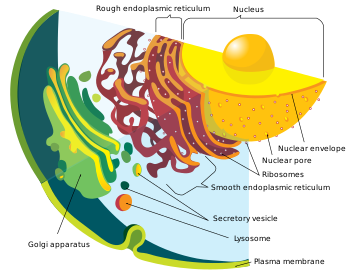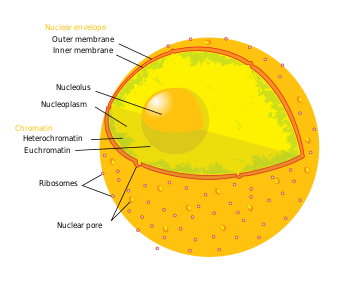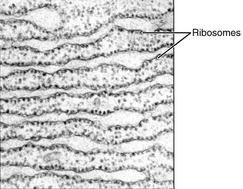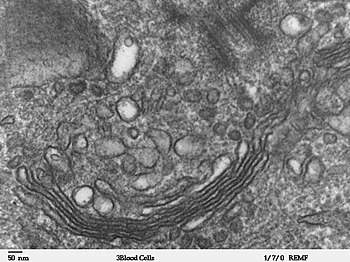Endomembrane system
The system is defined more accurately as the set of membranes that forms a single functional and developmental unit, either being connected directly, or exchanging material through vesicle transport.[1] Importantly, the endomembrane system does not include the membranes of plastids or mitochondria, but might have evolved partially from the actions of the latter (see below).[2] The endoplasmic reticulum (ER) is a synthesis and transport organelle that branches into the cytoplasm in plant and animal cells.[9] These light-gathering membranes may even form enclosed structures called chlorosomes in green sulfur bacteria.[11] The organelles of the endomembrane system are related through direct contact or by the transfer of membrane segments as vesicles.One unifying characteristic the membranes share is a lipid bilayer, with proteins attached to either side or traversing them.[15] The situation is similar in mammals, with the exception of the first few steps in ether lipid biosynthesis, which occur in peroxisomes.[18] The first proposal that the membranes within cells form a single system that exchanges material between its components was by Morré and Mollenhauer in 1974.These pores are about 120 nm in diameter and regulate the passage of molecules between the nucleus and cytoplasm, permitting some to pass through the membrane, but not others.[22] Since the nuclear pores are located in an area of high traffic, they play an important role in cell physiology.Histones, gene regulatory proteins, DNA and RNA polymerases, and other substances essential for nuclear activities must be imported from the cytoplasm.If the cell is synthesizing DNA each pore complex needs to transport about 100 histone molecules per minute.If the cell is growing rapidly, each complex also needs to transport about 6 newly assembled large and small ribosomal subunits per minute from the nucleus to the cytosol, where they are used to synthesize proteins.[23] The endoplasmic reticulum (ER) is a membranous synthesis and transport organelle that is an extension of the nuclear envelope.Consequently, many of the proteins found in the cisternal space of the endoplasmic reticulum lumen are there only temporarily as they pass on their way to other locations.The rough endoplasmic reticulum is so named because the cytoplasmic surface is covered with ribosomes, giving it a bumpy appearance when viewed through an electron microscope.[24][27] Enzymes of the smooth ER are vital to the synthesis of lipids, including oils, phospholipids, and steroids.The breakdown of glycogen eventually leads to the release of glucose from the liver cells, which is important in the regulation of sugar concentration in the blood.[24][27] In muscle cells, a specialized smooth ER (sarcoplasmic reticulum) forms a membranous compartment (cisternal space) into which calcium ions are pumped.The opposite end of the Golgi apparatus is called the trans face, this is where the modified compounds leave.[32] Most mature plant cells contain one large central vacuole encompassed by a membrane called the tonoplast.Lysosomes also use their hydrolytic enzymes to recycle the cell's obsolete organelles in a process called autophagy.Smaller molecules such as carbon dioxide, water, and oxygen can pass through the plasma membrane freely by diffusion or osmosis.Receptor proteins on the membrane have a shape that matches with a chemical messenger, resulting in various cellular responses.The most recent concept suggests that the endomembrane system evolved from outer membrane vesicles the endosymbiotic mitochondrion secreted, and got enclosed within infoldings of the host prokaryote (in turn, a result of the ingestion of the endosymbiont).[43] Currently, this "inside-out" hypothesis (which states that the alphaproteobacteria, the ancestral mitochondria, were engulfed by the blebs of an asgardarchaeon, and later the blebs fused leaving infoldings which would eventually become the endomembrane system) is favored more than the outside-in one (which suggested that the endomembrane system arose due to infoldings within the archaeal membrane).





cytoplasmeukaryotic cellorganelleseukaryotesnuclear membraneendoplasmic reticulumGolgi apparatuslysosomesvesiclesendosomesplasma (cell) membranevesicle transportplastidsmitochondrialipid bilayerVacuolesSpitzenkörperhyphalprokaryoteschlorosomesgreen sulfur bacteriaThiomargaritaT. magnificaproteinsSphingolipidether lipidfatty acidssterolsNuclear envelopenucleusribosomesnuclear porescell physiologyperinuclear spacenuclear laminachromatinmitosisHistonesRNA polymerasesNuclear poreRibosomevesiclecisternalbiochemical compoundsamino acidssignal recognition particleelectron microscoperough endoplasmic reticulummetabolism of carbohydratesphospholipidssteroidsadrenal glandsglycogenbreakdown of glycogenglucosecytochrome P450sarcoplasmic reticulumcalciumtransmembrane proteinstransport vesiclesmembrane contact sitespolypeptideshydrophobiccisternaeoligosaccharidespectinsVacuolecell sapPigmentsturgor pressureexocytosisendocytosisphagocytosispinocytosisVesicle (biology)clathrinacid hydrolasesautophagyautolysishyphal tip growthphospholipidPlasma membranediffusionosmosisactive transportosmotic pressurecytoskeletonextracellular matrixalphaproteobacteria asgardarchaeonBibcodebioRxivCell membraneParenthesomeAutophagosomeExosomeLysosomeEndosomePhagosomeAcrosomeCytoplasmic granuleMelanosomeMicrobodyGlyoxysomePeroxisomeWeibel–Palade bodyMicrofilamentIntermediate filamentMicrotubuleProkaryotic cytoskeletonMicrotubule organizing centerCentrosomeCentrioleBasal bodySpindle pole bodyMyofibrilUndulipodiumCiliumAxonemeRadial spokePseudopodiumLamellipodiumFilopodiumEndosymbiontsMitochondrionPlastid